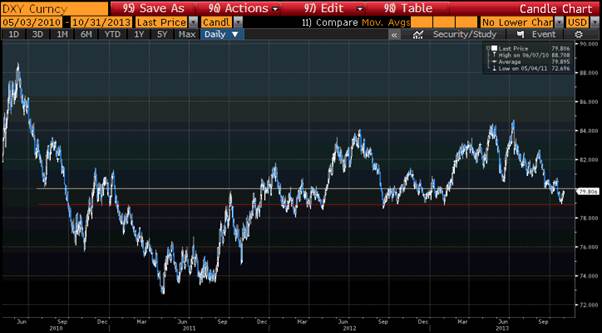Asian markets are mostly weaker as the investment community digests the comments from the FOMC meeting and what they imply for the Fed’s asset purchase programme going forward.
S&P futures are down around 0.4% from the US close, and this in turn is weighing on regional markets. The Fed came in less dovish than what the market was positioned for and highlighted that the recent fiscal drama only marginally impacted its overall assessment of the economy. Surprisingly the Fed showed absolutely no concerns about the recent government shutdown and expressed no worry at all about the budget negotiations in January and February.
It also removed the line around a tightening of financial conditions due to higher longer-term rates and thus seems quite content with where bond yields are right now. The Fed’s statement was largely unchanged from September as it highlighted it sees progress but is waiting for more evidence that the progress will be sustained. The Fed was very non-committal, but mostly glass half-full as it highlighted a moderate pace of expansion. The odds of tapering by December have certainly ticked up but judging from recent data releases; it’s still a stretch for it to taper this year.
Europe pointing lower
European markets are facing a weaker open today, with the major bourses facing drops of around half a per cent. There is a bit of activity on the European calendar today with German retail sales, consumer climate and import prices due out. At 21:00 AEDT we get eurozone inflation estimates and the market is pricing in a 1.1% increase on the year. This is still well below the ECB’s target of 2%, so we could see some volatility in the EUR depending on the inflation print. US economic data is more important than ever now with only a couple more payroll reports before December.
We certainly haven’t seen enough evidence to suggest some bumper reports are on the way after ADP non-farm employment change disappointed in US trade. Later today we have unemployment claims due out with an expected fall to 341,000. With the FOMC meeting out of the way, there will be plenty of focus on comments by Fed members. Mr Bullard, Mr Lacker and Mr Kocherlakota get the ball rolling this week. Given Mr Bullard is a well-known dove, his comments will be interesting after the Fed came out with a less dovish tone. The greenback is perhaps the most interesting to keep an eye on in the near term as it enjoys a modest recovery. The dollar index pushed higher regardless and was last at 79.81, within striking distance of the 80 mark. I feel 80 is the level to look out for in the near term and a close above that would be bullish for the DXY.
Nikkei choppy ahead of the BoJ
Taking a closer look at Asian equities, the Nikkei was trading lower for most of the session after having gotten off to a promising start riding off the moves in USD/JPY. The BoJ concluded its meeting today with no change in policy as expected. While the BoJ wasn’t really expected to add to stimulus, Governor Kuroda’s language will be important as he might use this opportunity to talk down the yen and push USD/JPY higher. The pair is stuck in a triangle pattern at the moment, which seems to be tightening up now and this would lead to a break higher/lower in the short term. Markets in China are also weaker despite news that the PBoC will inject 16 billion yuan into the system via 14-day reverse repos today. This move calmed interbank rates, but equities are yet to respond. Bucking the trend is Australia where the ASX 200 was flat on some month-end rebalancing.
ASX 200 outperforming
The local market reversed early losses and traded mildly positive for most of today before finishing the day a touch weaker. Perhaps the most significant moves are in the financial space, with reporting kicking into gear this week. NAB reported today, but unfortunately didn’t get quite the euphoric reaction ANZ received, despite reporting a record profit. The final cash earnings of $5.936 billion was the thinnest of beats, with the street expecting $5.93 billion (medium estimate).
NAB continues to build solid growth in lending, personal and wholesale banking. The bank also saw lower bad and doubtful debts and improved margins for personal banking, which helped it register this final figure. While the result is solid, it probably didn’t justify the nearly 50% gain it has posted this year. This resulted in some profit taking with support kicking in around $35. NAB remains the cheapest of all the big four at a P/E of around 13 times earnings. Perhaps this is justified but the mere fact that NAB continues to deliver on dividends might be enough to see it find some buyers at these levels and close the gap.
